Indian Relay | Native American Horse Racing
PBS Learning Media: Physical Education - Kids In Motion: Indian Relay | Native American Horse Racing
Indian Relay shows Indian America like it has never been seen before, following three teams across a perilous Indian Relay horse-racing season, from the bitter cold of winter to the mayhem of the summer’s championship races, culminating with the Indian Relay National Championships in Blackfoot, Idaho.
The hope and determination of modern-day American Indian life is revealed in this film about what it takes to win one of the most exciting and perilous forms of horseracing practiced anywhere in the world today. From the bitter cold of winter on the Rocky Mountain front to the heat and mayhem of the summer’s championship races in Montana and Idaho, Indian Relay follows three teams from three different American Indian communities as they prepare for and compete across a grueling Indian Relay season—all hearts set on the glory and honor of winning an Indian Relay National Championship.
A mix of high-speed daring and exquisite horsemanship, Indian Relay is a sport widely enjoyed and practiced by men and women from tribal nations across the Rocky Mountain West. Each race begins with up to eight Indian athletes riding a horse bareback around a track at full gallop. After one lap, barely slowing down, the riders leap from their speeding horses to a second set of horses. Each team’s “mugger” must then catch the first horse or the team will be disqualified, creating a chaotic melee of up to 32 people and 24 thoroughbreds in front of the grandstands. Another top-speed lap, another daring horse change, and the teams race for the finish line, at speeds topping 40 miles an hour.
For more information on this title, visit Vision Maker Media.
Sensitive: This resource contains material that may be sensitive for some students. Teachers should exercise discretion in evaluating whether this resource is suitable for their class.
Objectives
1. Learn about the competition that is Indian Relay and how Indian Relay demonstrates different tribal identities. Learn how generational concerns and the concept of heroes permeates the film. Activities 2, 4, 7 & 8 fulfill this objective
2. Gain appreciation and acceptance that while there are differences in traditions, cultures, and training among the three major teams – M&M, Tissidimit, and Murray – participating in Indian Relay supports them as members of the wider Indian Nation. Activities 1, 3,6, 7 & 9 fulfill this objective
3. Be active questioners and critical viewers while analyzing materials and resources. Activity 8 fulfills this objective
4. Develop an understanding of issues related to competition and Native identity. Activities 1, 2, 5, 7 & 8 fulfill this objective
5. Examine how the approaches each team takes to training is indicative of their individual Native identity – one team is new and virtually on its own, one is rich with community support because there is a long history of success, and the other is focused on family and looking to the future. Activities 2, 7 & 8 fulfill this objective
6. Recognize that participating in Indian Relay is a conundrum; teams compete against other Indian teams, which should widen the gap between them, but it solidifies their identities as members of the larger Indian Nation. Activity 6, 7 & 8 fulfill this objective
Procedures , Materials & Resources by activity
1 Did you know? “When the horse came to the Indian, our life got very prosperous. And I think in the back of our mind, we relate those. It’s glory. It’s excitement. But it’s prosperity at the same time. So when your cousin’s brother or something is riding that fast horse around there, everybody draws to it, and they relate to it.” Write the following quote from Carol Murray on the board prior to students entering class, have butcher paper or freezer paper fastened to the wall.
PLAY: Video clip 1: Carol Murray explains the importance of the horse to her people.
After viewing the clip the teacher tells students that he/ she is not quite sure if this is an accurate statement for all Nations and that the students will take available information and see if they can find any correlation between the statement and four timelines provided.
Procedures (45 minutes)
A. Students will be separated into four groups – one will use the Blackfeet timeline, one will use the Crow timeline, one will use the Shoshone- Bannock timeline, and one will use the timeline of the horses in America.
B. The teacher will have butcher paper or freezer paper fastened to a flat surface such as a wall.
C. Each group will determine what events and dates are really important to their Nation or, for the horse group, the history of the horse. (10 minutes total)
D. Using their particular timelines, students will determine what the earliest date should be on the class timeline and how the dates should be represented across the top of the timeline to most accurately depict events. (5 minutes)
E. Using markers, students will add important events from their group to the class timeline. (10 minutes)
F. As a class, but working in their groups, students correlate information from the timeline to assess commonalities and whether or not Carol Murray’s statement can be supported by the timelines. (15 minutes)
Materials & Resources
Butcher or freezer paper, markers, “Did you know” sheets (p.20-22), Timeline worksheet (p.32) and Blackfeet (p.23-24),Crow (p.25-27), Shoshone-Bannock (p.28-29), and horse (p.30-31) timelines. All videos found at visionmakermedia.org/educators/indian-relay/videos
-Carol Murray
Evaluation
Did the students show an understanding?
Did the students present their ideas clearly?
Did the student bring current information into today’s work?
“Did you know comparison” – students will be graded for group activity – did they accurately portray their timeline? Did they actively participate in the whole class activity?
Vocabulary
Procedures (50 minutes + assignments)
Write select vocabulary words from film on the board before class starts to get students thinking about subject material.
Indian Nation words: Apsaaloke, Shoshone-Bannock, Nittsitape-Blackfeet, tribe, clan, smudge, honor, regalia, breech cloth, moccasins
Indian Relay terms: mare, horsemanship, exchange, disqualified, lengths, holders, muggers
Other terms: unpredictable, prosperous, competitive, hero
A. When students enter the room, give them the vocabulary handout and have them fill in descriptions of the words as best as they can (column 2) – no prompts from the teacher, just filling out the worksheet
Play: Video clip 2: Big Race for Murray team
B. Ask students what they saw during the race (possible answers are different clothes, the exchange, the roles of people on the track).
C. Tell students that you are going to concentrate on the relay terms from the board right now, but they need an understanding of the other terms as they relate to relay.
D. Go back to the vocabulary handout (column three) have students make any corrections based on what they have seen. Have a class discussion about this vocabulary, keeping in mind that some of these terms are very difficult to put into words – have students give their definitions for words.
Play:YouTube video of Kentucky Derby
E. Have students go back to their comparison sheet (column 4) to compare and contrast this relay with a “regular” horse race.
F. Ask students to share how this relay differs from a race like the Kentucky Derby – and whether or not participants from one would be successful if they traded sports.
Play:Video clip 3: Kendall Old Horn on Indian Relay
Play: Video clip 4: Carol Murray on Myles’ training
G. In whole class discussion, ask how the two training methods differ – who do they think will be more successful? What kind of training do the students think would be necessary?
H. Handout homework worksheet: How do you train?
Materials & Resources
Vocabulary worksheet (p.34), pens, homework assignment (p.36), White board, markers, YouTube clip of Kentucky Derby https://www.youtube.com/watch?v=5tn9hye7U6g
All videos found at visionmakermedia.org/educators/indian-relay/videos
Evaluation
Did the students show an understanding?
Did the students present their ideas clearly?
Did the student bring current information into today’s work?
Evaluation 1: Students individually fill out the vocabulary sheet – asking about their personal definition first lets the teacher know what prior knowledge the student had, then he/she can evaluate how they deduced information from the video clips. They are judged on their ability to compare and contrast these terms as they pertain to the Kentucky Derby race.
A. When students enter the room, give them the vocabulary handout and have them fill in descriptions of the words as best as they can (column 2) – no prompts from the teacher, just filling out the worksheet
Evaluation 2: Students fill out the homework assignment. Training is a large part of success in Indian Relay and having students talk about training in their personal context underlies the importance in Indian Relay.
Ideas for Action
Procedures (45 minutes + assignments)
We know that many Indians appreciate two worlds – their traditional arts and practices and contemporary life much the same as your students are living. This activity is designed to look at how participants in the video honor their heritage, while maintaining a contemporary life…and then comparing that to the lives of your students.
A. Have large pieces of paper around the room for students to use to share what family traditions have been passed down through their families… title one “birthdays at my house,” another “Thanksgiving,” another “school breaks,” another “when we dress up,” another “special music” and one that just says “other.”
B. Begin today’s class with a whole class discussion about heritage – share what is important to you that was passed down from your family ~ Thanksgiving traditions, how you celebrate birthdays, what your family did during school breaks. Have students take markers and add their family traditions to the sheets on the walls.
C. Before showing video clip, ask students to write down what they see in the clip that reflects traditional Indian heritage, and what reflects contemporary lives.
Play
Video clip 5: Parade in Browning
D. After watching the video clip, give students the “Ideas for action” handout. Explain that you want them to carefully look at how traditions are kept alive today or updated for today’s world. photo by Rick Smith video
Materials & Resources
Ideas for action handout (p.37), large sheets of paper to hang around the room, markers, video clip 5. All videos found at visionmakermedia.org/educators/indianrelay/videos
Evaluation
Did the students show an understanding?
Did the students present their ideas clearly?
Did the student bring current information into today’s work?
Students will choose one of the five options which each require some sort of product, something that should be shared class-wide. Your evaluation should be based on both output and presentation.
Writing Exercise
Procedures (45 minutes + assignments)
How does the theme of “heroes” permeate Indian Relay? How do students today think about heroes – who are their heroes, what makes a hero?
A. The day before you present this activity, ask your students to bring to class a picture of someone they consider a hero – the person can be current or past, personal or not.
B. Write Carol Murray’s quote on the board: “I got a bunch of little grandsons coming up, and they need a hero. I’d like it to be their oldest cousin.” -Carol Murray
C. Have students tape their “hero” picture on the wall when they start this class. When all are assembled, ask students to identify people they know (be prepared, some students will consider people you don’t think of as heroes!) and why that person might be considered a hero. Have one student keep track of these reasons then set up a categories chart (see example).
Again, remember that some students will have reasons for admiring a person – like they are famous or they have lots of money – but remind them that the topic is “heroes.”
You may have some people who are not familiar to the class as a whole – maybe someone’s parents or a poet or dancer that others don’t know-so you will have to talk about unsung heroes.
Play
Video clip 6: Carol Murray talks about heroes
D. Hand out writing activity sheet. Explain that you expect full sentences, thoughtful input, and correct formatting.
Materials & Resources
Categories sheet (p.38), markers, tape, paper, video clip 6. All videos found at visionmakermedia.org/educators/indianrelay/videos
Evaluation
Did the students show an understanding?
Did the students present their ideas clearly?
Did the student bring current information into today’s work?
Students will choose one of the five options which each require some sort of product, something that should be shared class-wide. Your evaluation should be based on both output and presentation.
What Would You Do?
Procedures (20 minutes + Journal assignments)
Today’s activity is designed to shed the light on stereotyping today. This is not designed to reinforce any of the stereotypes, just to talk about stereotyping.
A. Write Kendall Old Horn’s quote on the board: “It’s our competitive nature that puts us into this sport, and then it’s our pride that keeps us in it and keeps it going. And the number one thing over everything is the pride of our tribes, the pride of our Nations, why teams work so hard to do so good.” -Kendall Old Horn
Play Video clip 7: The Final Race
B. Talk about stereotypes, and have a scribe take notes on the board – do they always come from outside the group or does the group sometimes adopt the stereotype? Let’s talk about some standard stereotypes we see today.
When I say “smart people” what do you think of?
Do you all think that is accurate?
What do “smart people” themselves do to prove the stereotype?
Do you think they like being stereotyped?
What are the weaknesses associated with “smart people?”
When I say “the poor” what do you think of?
Do you all think that is accurate?
What do “the poor” do to disprove the stereotype?
Do you think they like being stereotyped?
What are the strengths of “the poor”?
C. Are there stereotypes associated with Native Americans? (Warning – you do not want to ask what they are, just if there are some!) Did you see any of those stereotypes in this film? Did you see anything in the film that are contrary to the stereotype?
D. How are Native Americans portrayed in the media today? Are there positive images, negative images, or neither? When is the last time you heard about Native Americans in the media, on social networks, online?
E. In our school, what are the stereotypes that you see? (You might write these on the board). Without naming names, what types of people fall into these categories? What do those people do to prove the stereotype? What do we expect from each of these groups? Think of people in these categories…what are their strengths that don’t fit with the stereotype – again, no names!
F. In your journal, answer the following questions: Do you think you fit into one of the stereotypes we listed on the board?
Do you think you fit into one of the stereotypes we listedon the board?
Which stereotype?
In what ways are you like the stereotype?
What are your strengths that are not typical of thestereotype?
Do you want to be in this stereotype in five years? Why? Ten years? Why?
Native Americans are sometimes stereotyped – in what ways is this positive?
Materials & Resources
Board, journal, pencils or pens, video clip 7, provided example (p.40). All videos found at visionmakermedia.org/educators/indianrelay/videos
Evaluation
Did the students show an understanding?
Did the students present their ideas clearly?
Did the student bring current information into today’s work?
Stereotyping happens in all cultures, to all groups of people. The purpose of this activity is to have the class, as a whole, have a discussion about stereotypes. The piece to evaluate is their own journal entry, which is quite personal.
Art Exercise
Procedures (20 minutes + time for student to work on sketches,
This activity is designed to look at contemporary Indian Ledger Art and the activity will have students produce an art work suitable for display. additional class period for creating final product]
A. Have students look at the following image, a contemporary take on Ledger Art.
Ledger Art link 1
B. Again, have students observe more contemporary Ledger Art, but there is a bit of a twist. Notice the other background pieces like banking slips, shipment notices. Link three is on music paper.
C. The assignment today is to create a visual piece done in ledger style inspired by Indian Relay. Students should find a variety of paper to recycle as the canvas for their artwork (the teacher can provide ledger paper but we suggest you ask students to find their own because that will add to their creativity and ownership). They can add to the background – maybe an image of a program found online from one of the relays, an image from a tribal flag, clan images. Then they use this background as the paper for their project – we strongly suggest that the students sketch out their picture far in advance of putting it on their “ledger” paper! They might want to pick up colors in their background to use in their picture. They might want to portray the race itself, one of the horses, a spectator, the exchange – whatever.
You can use this class period for sketching and assign the work for homework, or use additional class periods for creation.
Post creations on school web site, share as hall art, hold an exhibit
Materials & Resources
Ledger paper, art materials, scratch paper for sketching and web links below
Evaluation
Did the students show an understanding?
Did the students present their ideas clearly?
Did the student bring current information into today’s work?
You will evaluate the art product here. We suggest a “gallery” showing either during class or perhaps in a hallway or school art gallery.
Physical Education Exercise
Procedures (45 minutes + assignment]
Students will evaluate how six domains of human behavior are represented in Indian Relay.
A. Have the “pie chart” of domains displayed in the front of the class (on the board or via Power Point, for example) and talk about each of them…have students determine what types of things should be listed in each section… suggestions might be…
Physical – nutrition, exercise, sleep, drug use, alcohol
Intellectual – planning, organizing
Spiritual – belief in something bigger than oneself – in some that is religion, but in others it might be belief in nature or Karma or the future
Social – teamwork, relating to others, parenting
Environmental – Nature, the spirit of the horse, how landscape contributes
Emotional – what teams have invested emotionally, family support, relationships (with others and with horses), competition and cooperation.
B. Divide the class into small groups, give each one of them their own pie chart and have them:
1. go through Indian Relay again and determine how each segment fits into one of the six “pie pieces”
OR
2. have students begin with an empty chart and remember, from previous showings of Indian Relay, what fits where.
C. As the whole class, bring their individual group work into a whole – are there similarities, are there cross overs, are there differences? The point you want to leave them with is that it takes all parts to develop a well-rounded individual – one who works independently, yet works with others; one who can think about details while keeping the bigger goal in mind; one who honors the past while living in the present and planning for the future; one who knows that healthy physical choices can lead to a healthier emotional life.
Materials & Resources
Board, pie chart display, handout with chart (p.41)
Evaluation
Did the students show an understanding?
Did the students present their ideas clearly?
Did the student bring current information into today’s work?
Evaluation is based on class participation and the group handout on the six components of human behavior.
In Review
Procedures ( 45 minutes]
This activity is designed to wrap up the entire Indian Relay experience. You will have students each contribute to wrap-up – while you will have large sheets of paper for each question posted around the room, every student will have to post an answer for each question by writing their responses on index cards that will be posted to the larger sheets. Names on the back ensure that you can associate comments with individual students, but will make it so that responses will not appear with names attached as they post to the larger sheets.
A. On the board:
Indian Relay is about horse racing…at least that is what it looks like, but it is so much more!
B. Around the room, post the following questions:
- What are the lasting images you have of the Crow, Blackfeet, and Shoshone-Bannock Nations?
- What are the values that participants want to pass on to their children – can you give examples?
- How does individual family pride contribute to training, participation and competition in Indian Relays?
- How does pride in one’s Nation contribute to training, participation, and competition in Indian Relays?
- What family issues are integral to this story?
- Which of the participants would you like to meet? why?
C. Each student will have 6 index cards and will use one for each question. When they have written their response, write their name on the back of the card. Students then attach that card response side out—on the appropriate sheet.
Materials & Resources
Large sheets of paper, 6 index cards for each student, markers, pens
Evaluation
Did the students show an understanding?
Did the students present their ideas clearly?
Did the student bring current information into today’s work?
Evaluation is based on each student’s index cards
Essential Understandings Regarding Montana Indians
Article X of the 1972 Montana Constitution stated “The state recognizes the distinct and unique cultural heritage of the American Indians and is committed in its educational goals to the preservation of their cultural integrity.” One way that this has been implemented in the educational system in Montana is by incorporating “Essential Understandings Regarding Montana Indians” as a part of their Common Core.
Sourced: http://www.opi.mt.gov/pdf/indianed/resources/essentialunderstandings.pdf
Essential Understanding 1: There is great diversity among the 12 tribal Nations of Montana in their languages, cultures, histories and governments. Each Nation has a distinct and unique cultural heritage that contributes to modern Montana.
Essential Understanding 2: There is great diversity among individual American Indians as identity is developed, defined and redefined by entities, organizations and people. A continuum of Indian identity, unique to each individual, ranges from assimilated to traditional. There is no generic American Indian.
Essential Understanding 3: The ideologies of Native traditional beliefs and spirituality persist intomodern day life as tribal cultures, traditions, and languages are still practiced by many American Indian people and are incorporated into how tribes govern and manage their affairs. Additionally, each tribe has its own oral histories, which are as valid as written histories. These histories pre-date the “discovery” of North America.
Essential Understanding 4: Reservations are lands that have been reserved by the tribes for their own use through treaties, statutes, and executive orders and were not “given” to them. The principle that land should be acquired from the Indians only through their consent with treaties involved three assumptions:
Essential Understanding 5: Federal policies, put into place throughout American history, have affected Indian people and still shape who they are today. Much of Indian history can be related through several major federal policy periods:
Essential Understanding 6: History is a story most often related through the subjective experience of the teller. With the inclusion of more and varied voices, histories are being rediscovered and revised. History told from an Indian perspective frequently conflicts with the stories mainstream historians tell.
National Curriculum Standards
Common Core Standards as they relate to Social Studies
Grade 6: Language and Literacy
College and Career Readiness Anchor Standards for Reading in Social Studies
Standard 7: Integration of knowledge and ideas: Integrate and evaluate content presented in diverse media and formats, including visually and quantitatively, as well as in words.
College and Career Readiness Anchor Standards for Writing in Social Studies
Standard 2: Write informative/explanatory texts to examine and convey complex ideas and information clearly and accurately through the effective selection, organization, and analysis of content.
College and Career Readiness Anchor Standards for Speaking and Listening in Social Studies
Standard 2: Comprehension and Collaboration: Integrate and evaluate information presented in diverse media and formats, including visually, quantitatively, and orally. Reading Standards for Informational Text in Social Studies.
Standard 7: Integration of Knowledge and Ideas: Integrate information presented in different media or formats (e.g. visually, quantitatively) as well as in words to develop a coherent understanding of a topic or issue.
Writing Standards in Social Studies
Standard 1 (A & B): Text Types and Purposes: Write arguments to support claims with clear reasons and relevant evidence
- Introduce claim(s) and organize the reasons and evidence clearly.
- Support claim(s) with clear reasons and relevant evidence, using credible sources, including oral sources, and demonstrating an understanding of the topic or text.
Standard 2 (B & F): Write informative explanatory texts to examine a topic and convey ideas, concepts, and information through the selection, organization, and analysis or relevant content.
- Develop the topic with relevant facts, definitions, concrete details, quotations, or other information and examples
- Provide a concluding statement or section that follows from the information or explanation presented.
Standard 3 (C):Write narratives to develop real or imagined experiences or events using effective technique, relevant descriptive details, and well-structured event sequences.
- Use a variety of transition words, phrases and clauses to convey sequence and signal shifts from one time frame or setting to another.
Standard 8: Gather relevant information from multiple oral, print and digital sources; assess the credibility of each source; and quote or paraphrase the data and conclusion s of others while avoiding plagiarism and providing basic bibliographic information for sources.
Speaking and Listening Standards in Social Studies
Standard 2: Interpret information presented in diverse media and formats (e.g. visually, quantitatively, orally) and explain how it contributes to a topic, text, or issue under study.
Language Standards in Social Studies
Standard 4 (A): Determine or clarify the meaning of unknown and multiple-meaning words and phrases based on grade 6 reading and content, choosing flexibly from a range of strategies: use context (e.g. the overall meaning of a sentence or paragraph; a word’s position or function in a sentence) as a clue to the meaning of a word or phrase.
Standard 5 (D): Demonstrate understanding of figurative language, word relationships, and nuances in word meanings: recognize the influence time, culture, gender and social relationships have upon word meaning.
Standard 6: Demonstrate understanding of figurative language, word relationships, and nuances in word meanings: recognize the influence time, culture, gender and social relationships have upon word meaning.
Grade 7: Language and Literacy
College and Career Readiness Anchor Standards for Reading in Social Studies
Standard 7: Integration of knowledge and ideas: Integrate and evaluate content presented in diverse media and formats, including visually and quantitatively, as well as in words.
College and Career Readiness Anchor Standards for Speaking and Listening in Social Studies
Standard 2: Comprehension and Collaboration: Integrate and evaluate information presented in diverse media and formats, including visually, quantitatively, and orally.
Reading Standards for Informational Text in Social Studies
Standard 3: Analyze the interactions between individuals, events, and ideas in a text (e.g. how ideas influence individuals or events, or how individuals influence ideas or events).
Standard 4: Determine the meaning of words and phrases as they are used in a text, including figurative, connotative, and technical meanings; analyze the impact of a specific word choice on meaning and tone.
Standard 6: Determine an author’s point of view or purpose in a text, including those by and about
American Indians, and analyze how the author distinguishes his or her position from that of others.
Reading Standards for Informational Text in Social Studies
Standard 1 (A & B): Write arguments to support claims with clear reasons and relevant evidence.
- Introduce claim(s), acknowledge alternate or opposing claims, and organize the reasons and evidence logically.
- Support claim(s) with logical reasoning and relevant evidence, using accurate, credible sources, including oralsources, and demonstrating an understanding of the topic or text.
Grade 7: Language and Literacy
Reading Standards for Informational Text in Social Studies
Standard 2 (B & F): Write informative explanatory texts to examine a topic and convey ideas, concepts, and information through the selection, organization, and analysis or relevant content.
- Develop the topic with relevant facts, definitions, concrete details, quotations, or other information and examples.
- Provide a concluding statement or section that follows from and supports the information of explanation presented.
Standard 3 (C & E): Write narratives to develop real or imagined experiences or events using effective technique, relevant descriptive details, and well-structured event sequences.
- Use a variety of transition words, phrases and clauses to convey sequence and signal shifts from one time frame or setting to another.
- Provide a concluding statement or section that follows from and supports the information of explanation presented.
Standard 8: Gather relevant information from multiple print and digital sources, using search terms effectively, assess the credibility and accuracy of each source; and quote or paraphrase the data and conclusions of others while avoiding plagiarism and following a standard format for citation.
Speaking and Listening Standards in Social Studies
Standard 2: Analyze the main ideas and supporting details presented in diverse media and format (e.g. visually, quantitatively, orally and explain how the ideas clarify a topic, text or issue under study.
Standard 5: : Include multimedia components and visual displays in presentations to clarify claims and finding and emphasize salient points.
Language Standards in Social Studies
Standard 4 (A): Determine or clarify the meaning of unknown and multiple-meaning words and phrases based on grade 7 reading and content, choosing flexibly from a range of strategies: use context (e.g. the overall meaning of a sentence or paragraph; a word’s position or function in a sentence) as a clue to the meaning of a word or phrase.
Standard 5(A): Demonstrate understanding of figurative language, word relationships, and nuances in word meanings: recognize the influence time, culture, gender and social relationships have upon word meaning.
Grade 8: Language and Literacy
College and Career Readiness Anchor Standards for Reading in Social Studies
Standard 7: Integration of knowledge and ideas: Integrate and evaluate content presented in diverse media and formats, including visually and quantitatively, as well as in words.
College and Career Readiness Anchor Standards for Speaking and Listening in Social Studies
Standard 2: Comprehension and Collaboration: Integrate and evaluate information presented in diverse media and formats, including visually, quantitatively, and orally.
Grade 8: Language and Literacy
Reading Standards for Informational Text in Social Studies
Standard 7: Evaluate the advantages and disadvantages of using different mediums (e.g. print or digital text, video, multimedia) to present a particular topic or idea.
Writing Standards in Social Studies
Standard 1 (A & B): Write arguments to support claims with clear reasons and relevant evidence.
- Introduce claim(s), acknowledge and distinguish the claim(s) from alternate or opposing claims, alternate or opposing claims, and organize the reasons and evidence logically.
- Support claim(s) with logical reasoning and relevant evidence, using accurate, credible sources, including oral sources, and demonstrating an understanding of the topic or text.
Standard 2 (B & F): Write informative explanatory texts to examine a topic and convey ideas, concepts, and information through the selection, organization, and analysis or relevant content.
- Develop the topic with relevant, well-chosen, facts, definitions, concrete details, quotations, or other information and examples.
- Provide a concluding statement or section that follows from and supports the information of explanation presented.
Standard 3 (C & E): Write narratives to develop real or imagined experiences or events using effective technique, relevant descriptive details, and well-structured event sequences.
- Use a variety of transition words, phrases and clauses to convey sequence, signal shifts from one time frame or setting to another, and show the relationships among experiences and events.
- Provide a conclusion that follows from and reflects on the narrated experiences or events.
Speaking and Listening Standards in Social Studies
Standard 2: Analyze the purpose of information presented in diverse media and formats (e.g. visually, quantitatively, orally) and evaluate the motives (e.g. social, commercial, political) behind its presentation.
Standard 4 (A): Determine or clarify the meaning of unknown and multiple-meaning words and phrases based on grade 8 reading and content, choosing flexibly from a range of strategies: use context (e.g. the overall meaning of a sentence or paragraph; a word’s position or function in a sentence) as a clue to the meaning of a word or phrase.
Standard 5 (A): Demonstrate understanding of figurative language, word relationships, and nuances in word meanings: recognize the influence time, culture, gender and social relationships have upon word meaning.
Grade 9 & 10: Language and Literacy
College and Career Readiness Anchor Standards for Reading in Social Studies
Standard 7: Integration of knowledge and ideas: Integrate and evaluate content presented in diverse media and formats, including visually and quantitatively, as well as in words.
College and Career Readiness Anchor Standards for Speaking and Listening in Social Studies
Standard 2: Comprehension and Collaboration: Integrate and evaluate information presented in diverse media and formats, including visually, quantitatively, and orally.
Grade 9 & 10: Language and Literacy
Reading Standards for Informational Text in Social Studies
Standard 1: Cite strong and thorough textual evidence to support analysis of what the text says explicitly as well as inferences drawn from the text.
Standard 3: Analyze how the author unfolds an analysis or series of ideas of events, including the order in which the points are made, how they are introduced and developed, and the connections that are drawn between them.
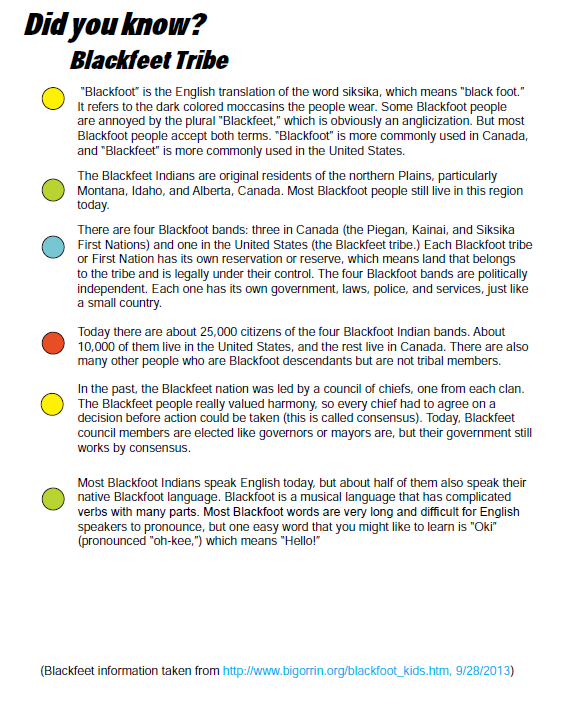
Information about Blackfeet Tribe
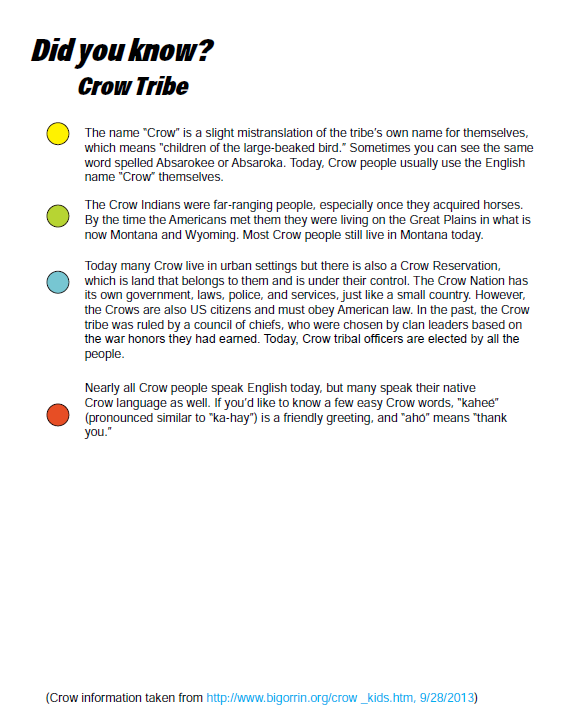
About Crow Tribe
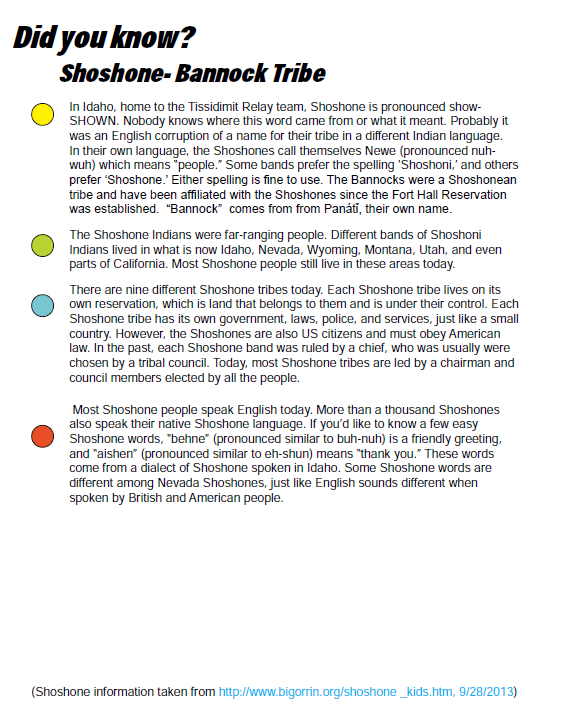
Shashone Tribe information
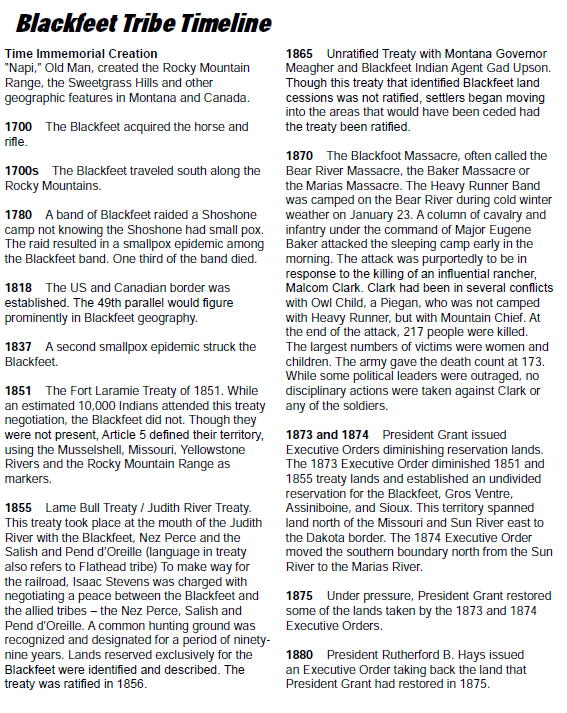
Timeline
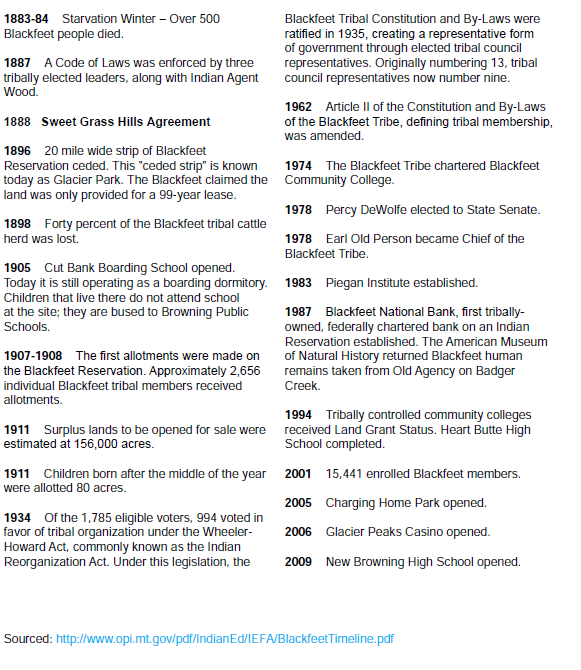
Blackfeet timeline continued
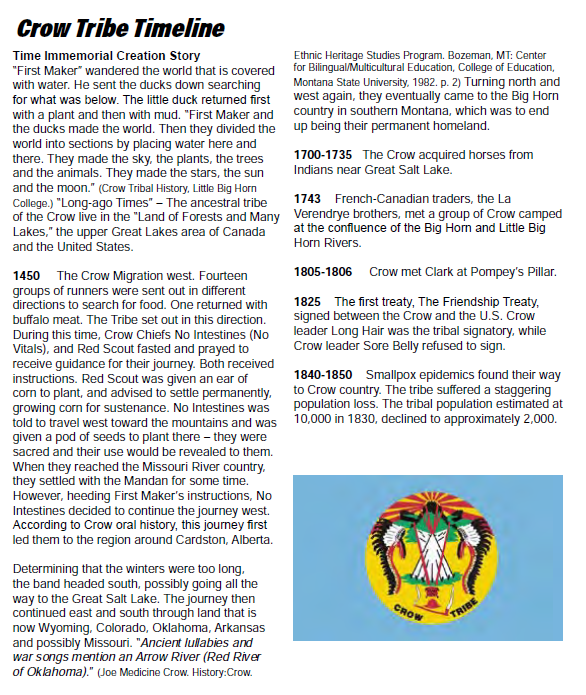
Crow Timeline
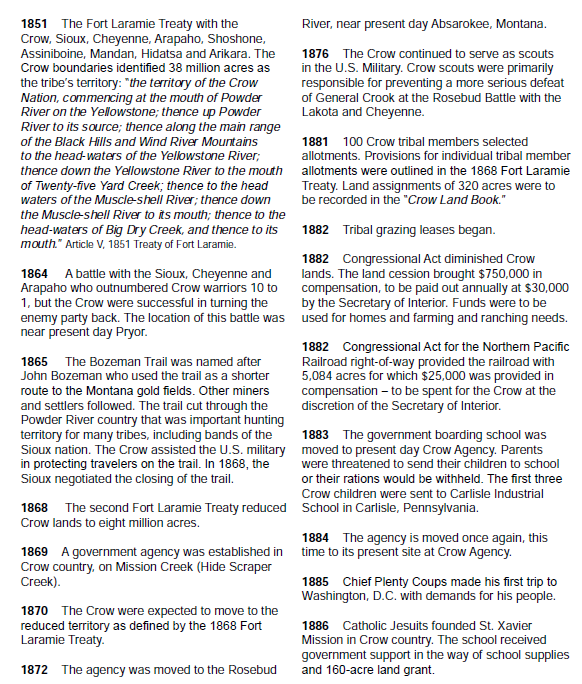
Crow Timeline continued
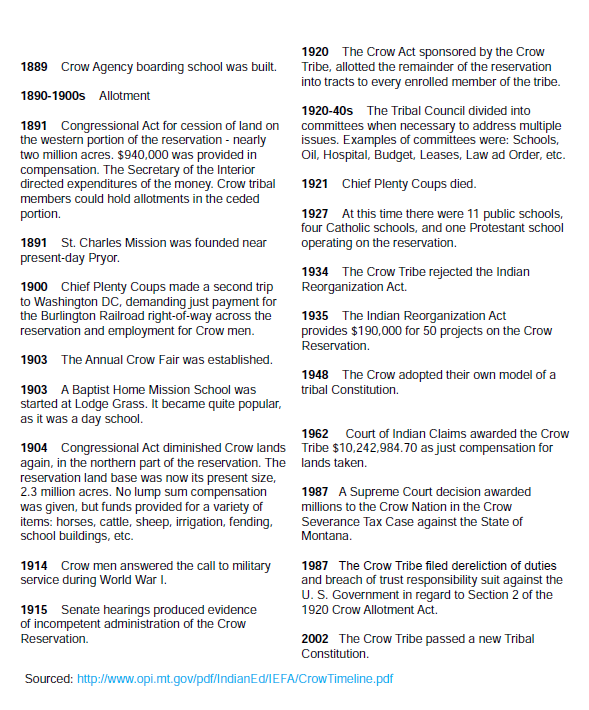
Crow Timeline Page 3
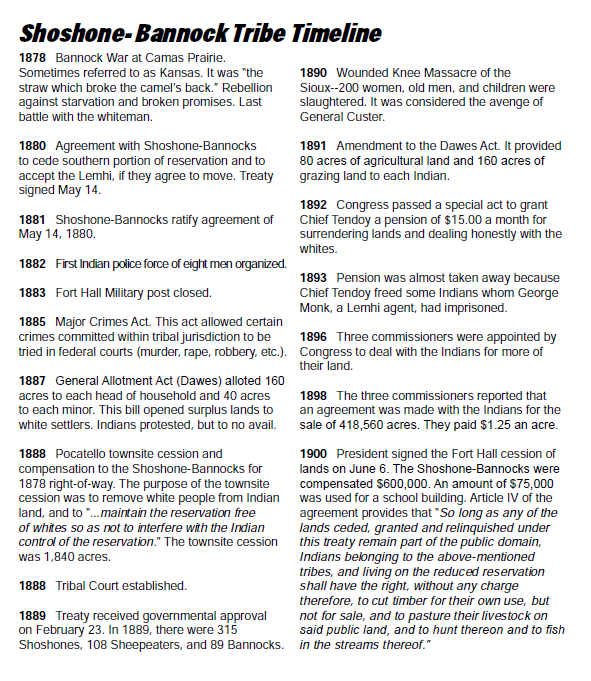
Shashone Timeline
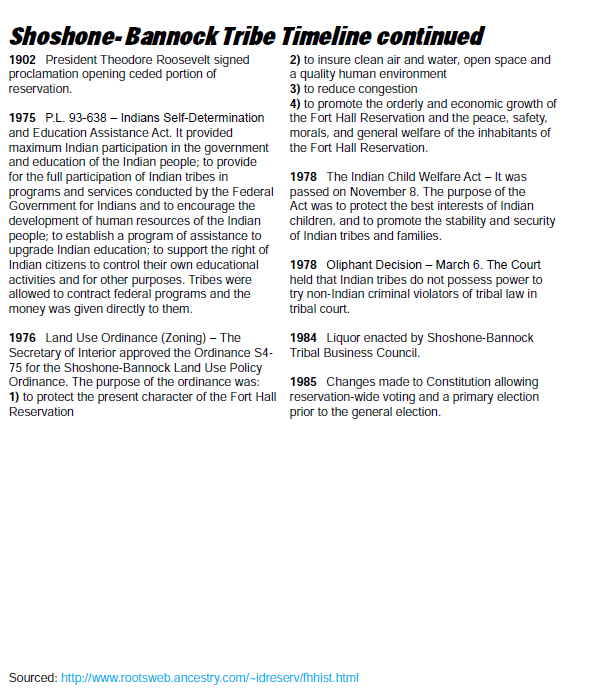
Shoshone Timeline Continued
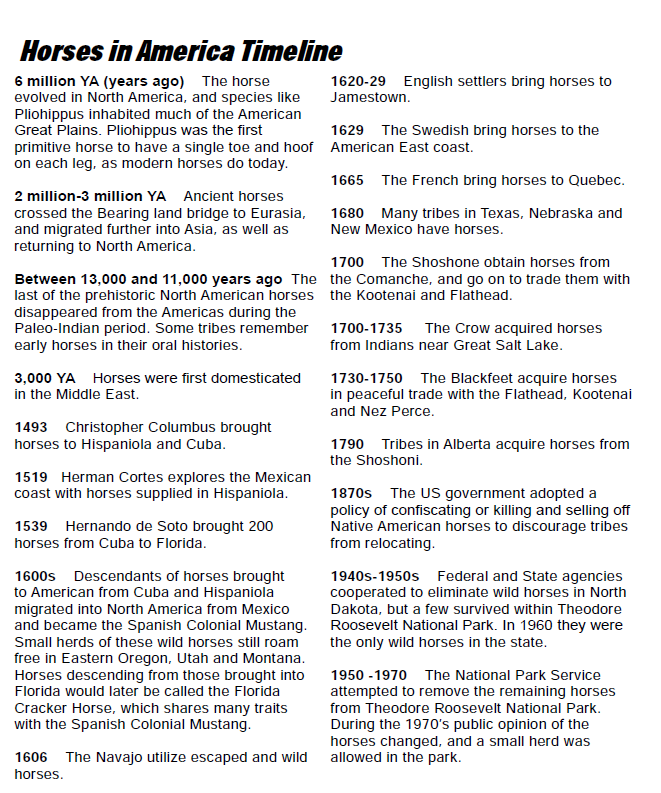
Horses in America Timeline
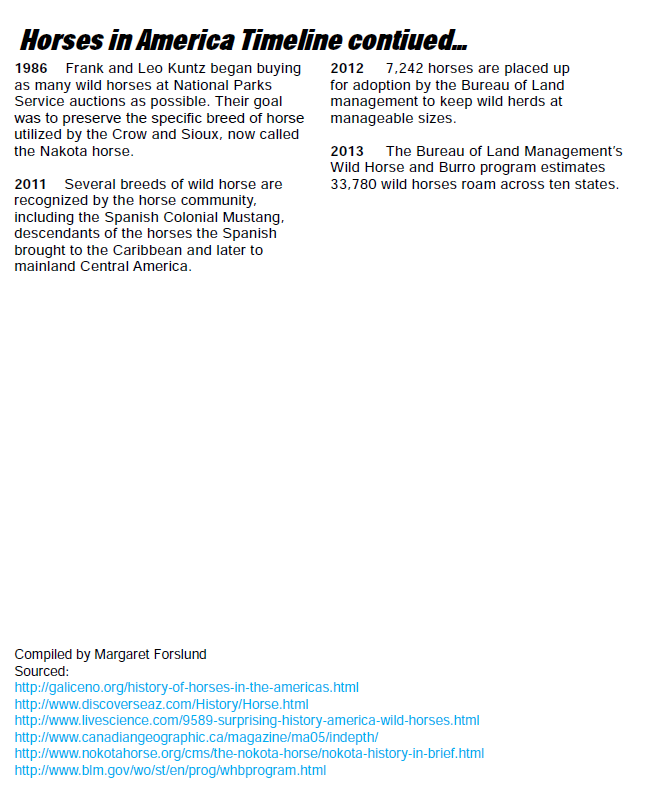
Horses Timeline Continued
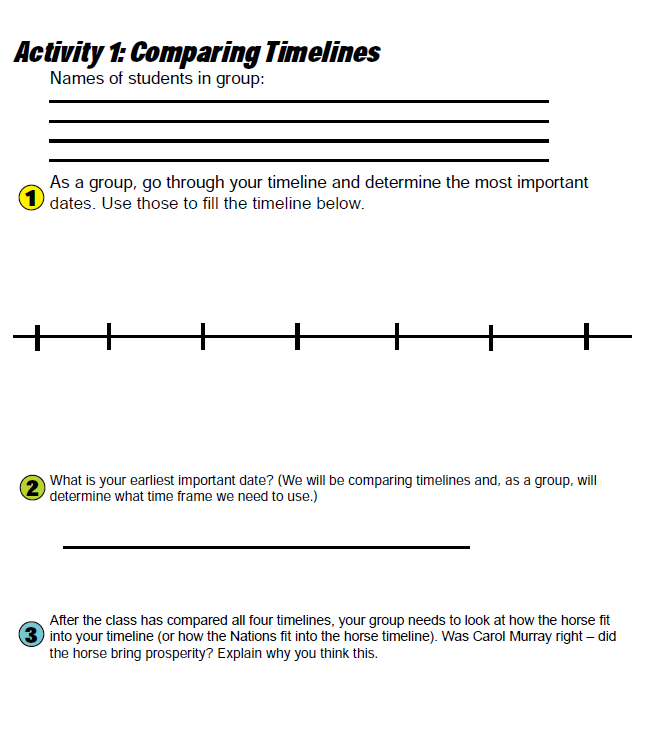
Activity 1
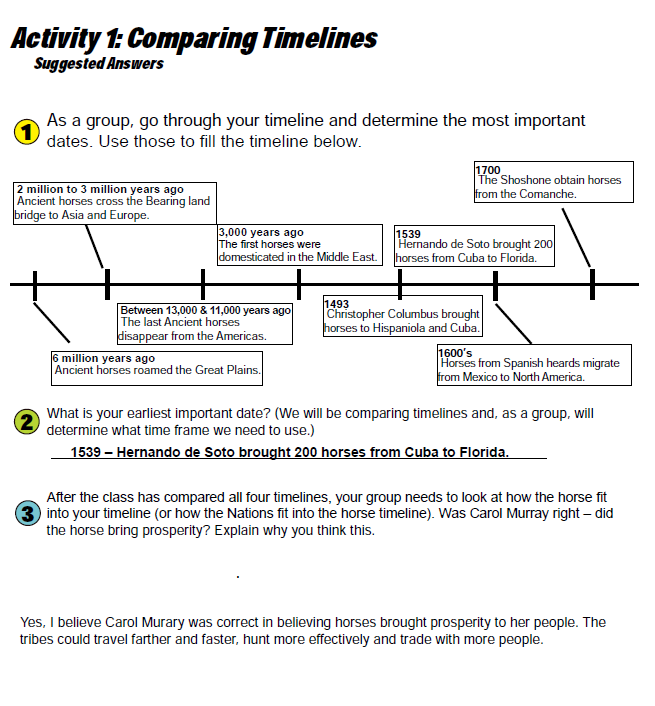
Activity 1 Answers
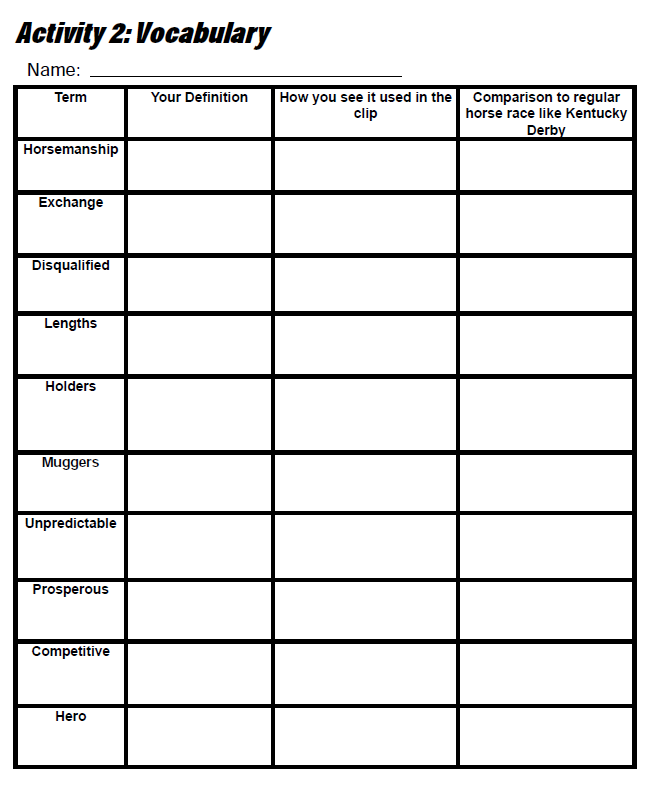
Vocabulary Page 1
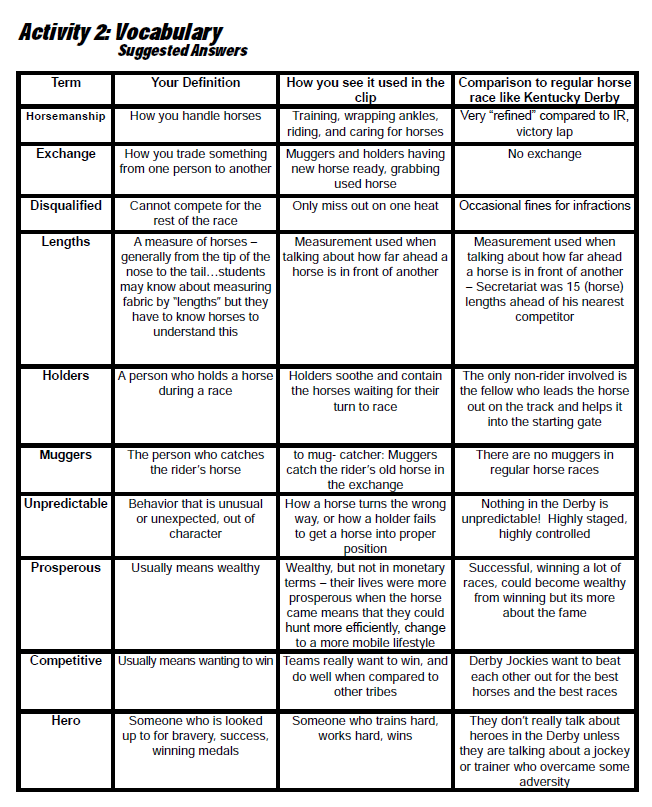
Vocabulary Answers
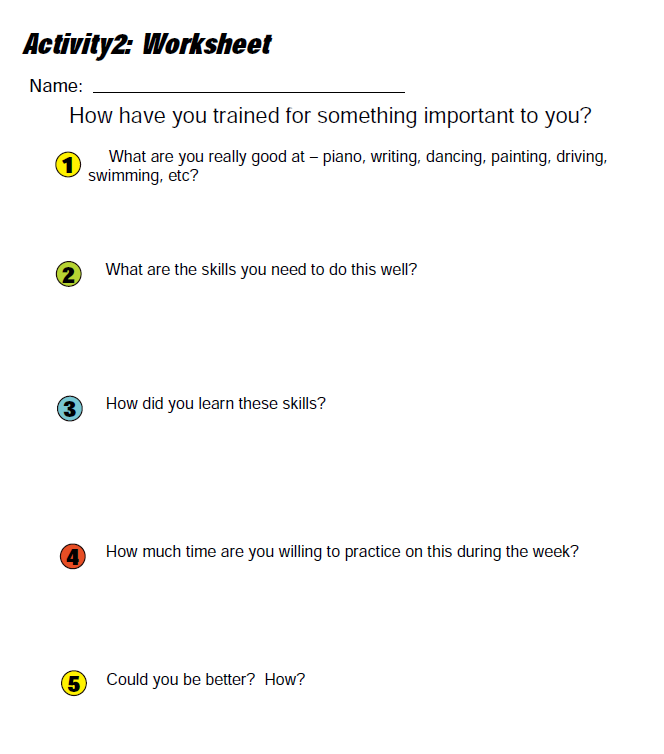
Activity 2 Worksheet
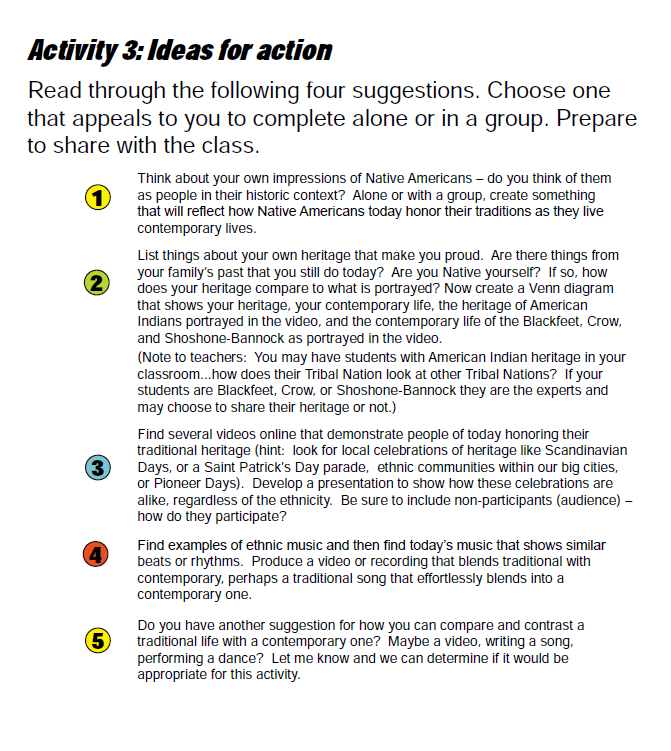
Activity 3 Ideas for action
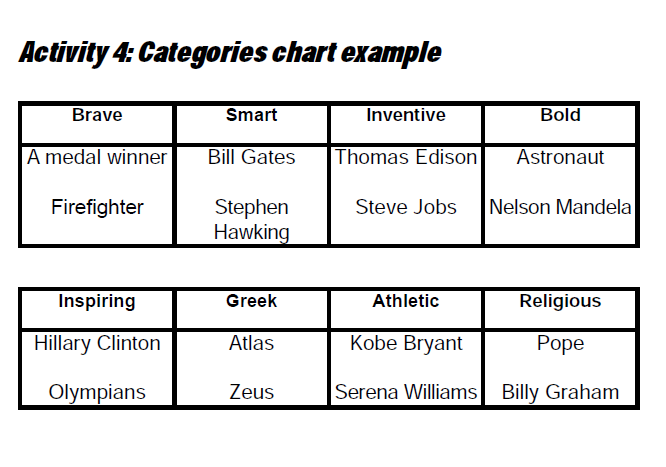
Activity 4
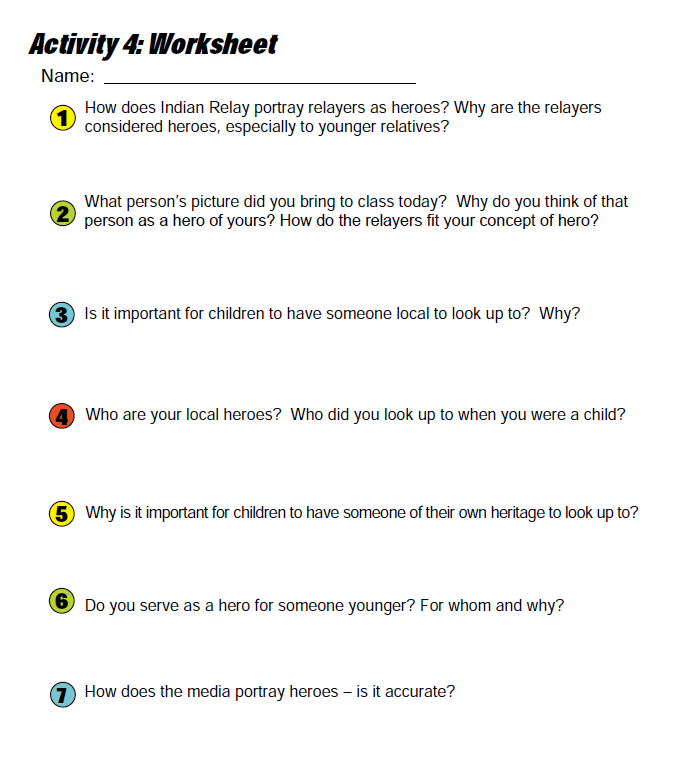
Activity 4 Worksheet
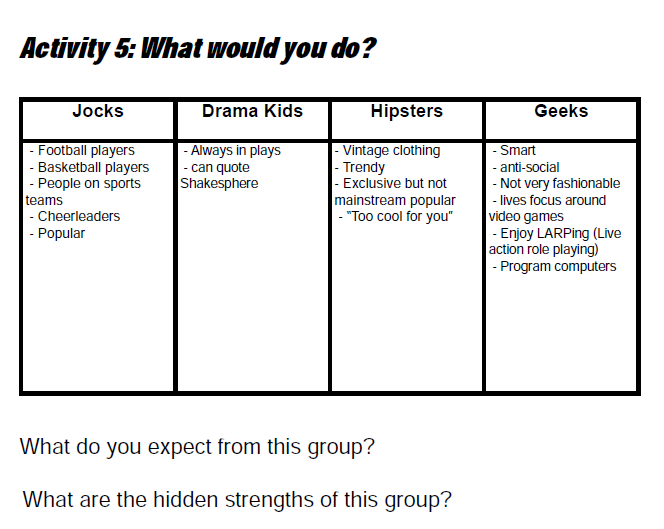
Activity 5
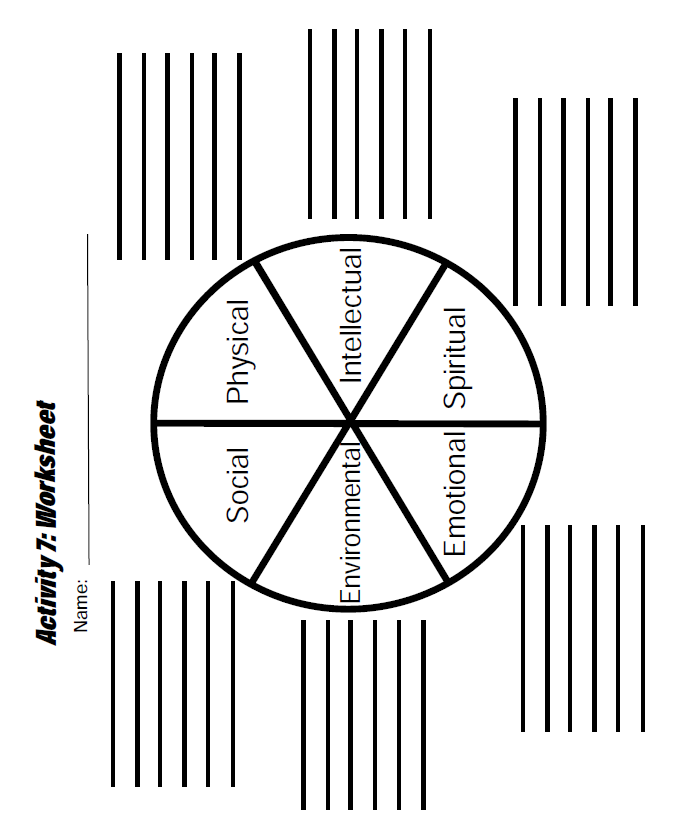
Activity 7 Worksheet
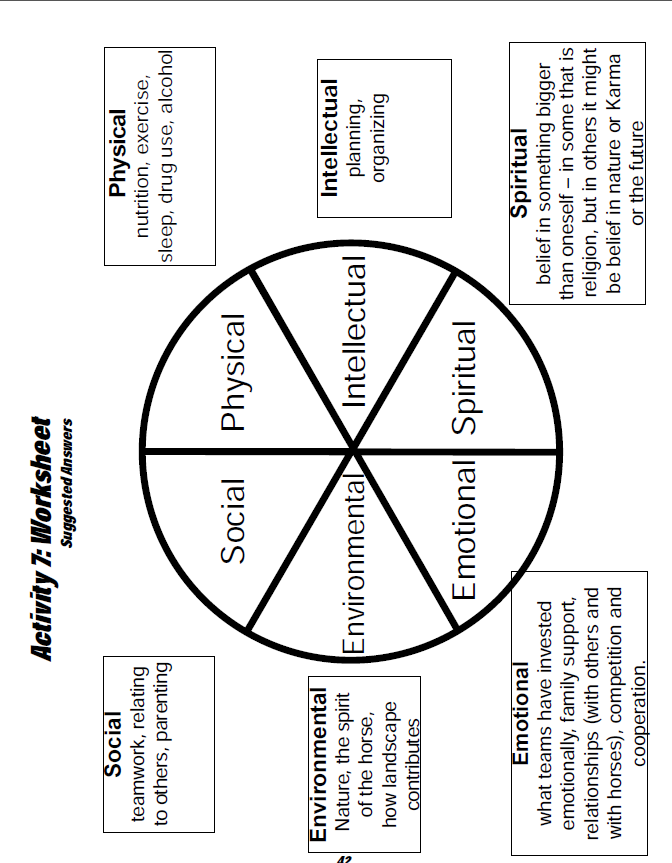
Activity 7 Answers
Additional Resources
Tribes Resources
Blackfoot Tribe - http://www.visitmt.com/places_to_go/indian_nations/niitsitapi-blackfeet/
Blackfeet Timeline - http://www.opi.mt.gov/pdf/IndianEd/IEFA/BlackfeetTimeline.pdf
Glenbow museum Blackfoot tribe Digital Exhibit- http://www.glenbow.org/blackfoot/
Blackfoot Background Information - http://www.bigorrin.org/blackfoot_kids.htm, 9/28/2013
Crow Timeline - http://www.opi.mt.gov/pdf/IndianEd/IEFA/CrowTimeline.pdf
Crow Background Information - http://www.bigorrin.org/crow _kids.htm, 9/28/2013
Shoshone Backgrounf Information - http://www.bigorrin.org/shoshone _kids.htm, 9/28/2013
Shoshone Background Timeline - http://www.rootsweb.ancestry.com/~idreserv/fhhist.html
Shoshone Bannock Tribe - http://www.shoshonebannocktribes.com/
Horse Resources
The Surprising History of America’s Wild Horses - http://www.livescience.com/9589-surprising-history-america-wild-horses.html
The Horse in North America - http://www.discoverseaz.com/History/Horse.html
The Arrival of Horses into the Americas - http://galiceno.org/history-of-horses-in-the-americas.html
North American Colonial Spanish Horse - http://www.centerforamericasfirsthorse.org/north-american-colonial-spanish-horse.html
Nokota History in Brief - http://www.nokotahorse.org/cms/the-nokota-horse/nokota-history-in-brief.html
Article about Indian Relay - http://missoulian.com/news/state-and-regional/daring-indian-relay-racing-featured-in-film/article_2d47fc0a-3a01-11e3-917d-001a4bcf887a.html
Essential Understandings - http://www.opi.mt.gov/pdf/indianed/resources/essentialunderstandings.pdf
Video Time Codes
All of the Lesson Plan Video Clips can be found online at www.visionmakermedia.org/ educators/indian-relay/ You can also use the time codes below to follow along on your Indian Relay DVD.
Video clip 1: Carol Murray explains the importance of the horse to her people (52:33 – 52:58)
Video clip 2: Big Race for Murray team (38:06 – 39:45)
Video clip 3: Kendall Old Horn on Indian Relay (09:14 – 10:42)
Video clip 4: Carol Murray on Myles’ training (10:43 – 11:42)
Video clip 5: Parade in Browning (22:52 – 25:07)
Video clip 6: Carrol Murray talks about heros (11:43-11:56)
Video clip 7: The Final Race (50:38 – 54:26)